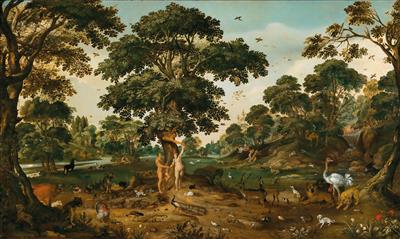Flemish School, 17th Century
[Saleroom Notice]
Adam and Eve in Paradise,
oil on panel, 74.5 x 125 cm, framed
Literature:
J. Briels, Peintres Flamands en Hollande au début du Siècle d’Or 1585–1630, Antwerp 1987, p. 194–197, fig. 244 (as Jacob Savery)
The present impressive work has, so far, eluded a convincing attribution. Whilst it is very close to works by the Bouttats family, it has been suggested that the panel was actually painted by an artist based in Germany or central Europe. The inclusion of a European bison seems to point to such an origin, as a bison would have been almost unheard of in the Netherlands at the time. European bison survived in a few natural forests in Europe, but their numbers dwindled. In the Polish–Lithuanian Commonwealth, European bison in the Białowieża Forest were legally the property of the Grand Dukes of Lithuania until the third partition of Poland. Wild European bison herds also existed in the forest until the mid-seventeenth century. Polish kings took measures to protect the bison. King Sigismund II Augustus instituted the death penalty for poaching a European bison in Białowieża in the mid-sixteenth century. In the early nineteenth century, after the partitions of the Polish Commonwealth the Russian tsars retained old Lithuanian laws protecting the European bison herd in Białowieża. Despite these measures and others, the European bison population continued to decline over the following century, with only Białowieża and Northern Caucasus populations surviving into the twentieth century. The last European bison in Transylvania died in 1790.
A tentative attribution to the Flemish-Polish painter Izaak van den Blocke (1575–1628) and his family has been suggested (see J. Tylicki, ‘The Van den Blocke Family in Gdańsk and in Central Europe’, in: K.A. Ottenheym, K. de Jonge (ed.), The Low Countries at the Crossroads. Netherlandish Architecture as an Export Product in Early Modern Europe (1480–1680), Turnhout 2013, pp. 143-57). Blocke painted a series of four paintings with scenes from the Old Testament made for the reception room of the mayor’s office on the first floor in the Town Hall in Gdańsk, now the Muzeum Historycznege.
Expert: Dr. Alexander Strasoldo
 Dr. Alexander Strasoldo
Dr. Alexander Strasoldo
+43 1 515 60 403
old.masters@dorotheum.com
11.05.2022 - 16:00
- Dosažená cena: **
-
EUR 36.237,-
- Odhadní cena:
-
EUR 20.000,- do EUR 30.000,-
Flemish School, 17th Century
[Saleroom Notice]Adam and Eve in Paradise,
oil on panel, 74.5 x 125 cm, framed
Literature:
J. Briels, Peintres Flamands en Hollande au début du Siècle d’Or 1585–1630, Antwerp 1987, p. 194–197, fig. 244 (as Jacob Savery)
The present impressive work has, so far, eluded a convincing attribution. Whilst it is very close to works by the Bouttats family, it has been suggested that the panel was actually painted by an artist based in Germany or central Europe. The inclusion of a European bison seems to point to such an origin, as a bison would have been almost unheard of in the Netherlands at the time. European bison survived in a few natural forests in Europe, but their numbers dwindled. In the Polish–Lithuanian Commonwealth, European bison in the Białowieża Forest were legally the property of the Grand Dukes of Lithuania until the third partition of Poland. Wild European bison herds also existed in the forest until the mid-seventeenth century. Polish kings took measures to protect the bison. King Sigismund II Augustus instituted the death penalty for poaching a European bison in Białowieża in the mid-sixteenth century. In the early nineteenth century, after the partitions of the Polish Commonwealth the Russian tsars retained old Lithuanian laws protecting the European bison herd in Białowieża. Despite these measures and others, the European bison population continued to decline over the following century, with only Białowieża and Northern Caucasus populations surviving into the twentieth century. The last European bison in Transylvania died in 1790.
A tentative attribution to the Flemish-Polish painter Izaak van den Blocke (1575–1628) and his family has been suggested (see J. Tylicki, ‘The Van den Blocke Family in Gdańsk and in Central Europe’, in: K.A. Ottenheym, K. de Jonge (ed.), The Low Countries at the Crossroads. Netherlandish Architecture as an Export Product in Early Modern Europe (1480–1680), Turnhout 2013, pp. 143-57). Blocke painted a series of four paintings with scenes from the Old Testament made for the reception room of the mayor’s office on the first floor in the Town Hall in Gdańsk, now the Muzeum Historycznege.
Expert: Dr. Alexander Strasoldo
 Dr. Alexander Strasoldo
Dr. Alexander Strasoldo
+43 1 515 60 403
old.masters@dorotheum.com
|
Horká linka kupujících
Po-Pá: 10.00 - 17.00
old.masters@dorotheum.at +43 1 515 60 403 |
| Aukce: | Obrazy starých mistrů I |
| Typ aukce: | Sálová aukce s Live bidding |
| Datum: | 11.05.2022 - 16:00 |
| Místo konání aukce: | Wien | Palais Dorotheum |
| Prohlídka: | 30.04. - 11.05.2022 |
** Kupní cena vč. poplatku kupujícího a DPH(Země dodání Rakousko)
Není již možné podávat příkazy ke koupi přes internet. Aukce se právě připravuje resp. byla již uskutečněna.
